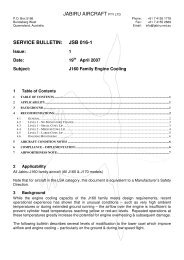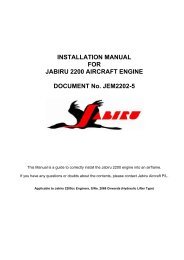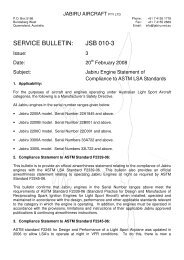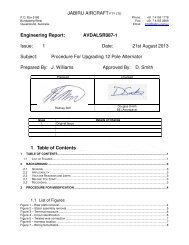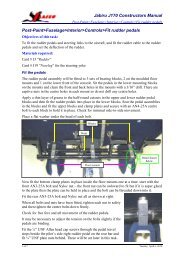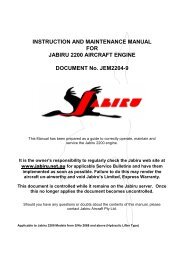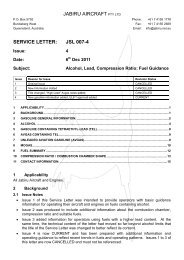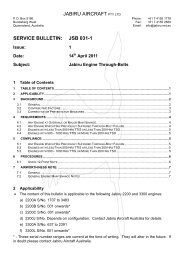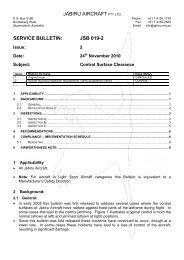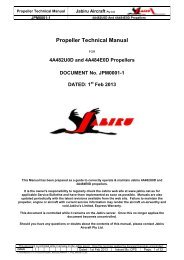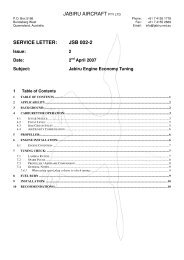INSTRUCTION AND MAINTENANCE MANUAL FOR ... - Jabiru Aircraft
INSTRUCTION AND MAINTENANCE MANUAL FOR ... - Jabiru Aircraft
INSTRUCTION AND MAINTENANCE MANUAL FOR ... - Jabiru Aircraft
Create successful ePaper yourself
Turn your PDF publications into a flip-book with our unique Google optimized e-Paper software.
<strong>Jabiru</strong> <strong>Aircraft</strong> Pty Ltd<br />
Instruction & Maintenance Manual<br />
<strong>Jabiru</strong> 3300 <strong>Aircraft</strong> Engine<br />
Hydraulic Valve Lifter Models<br />
OR – after the service, idle the engine, listen for loud tapping noises and feel for rough<br />
running. This must be carried out with the cowls removed. Note that due to the need to have<br />
a person at the controls of the aircraft, this is a two-person job.<br />
CAUTION:<br />
While ever the engine is running there must be a qualified person inside the aircraft, at the<br />
controls. Under NO circumstances run engine without a qualified person at the controls.<br />
Troubleshooting information is given in Section 12.<br />
Air can be caught inside the lifters after maintenance. Running the engine at a high idle -<br />
approx 1500 RPM – will expel the air but may take up to 15 minutes. When fitting lifters after<br />
inspection or maintenance they should be filled by injecting oil into the hole in the side of the<br />
lifter. Care must be taken to ensure all air is removed.<br />
Several different hydraulic lifters have been used in <strong>Jabiru</strong> 3300 engines. The cam P/No. fitted<br />
to the engine must be known when ordering replacement lifters. This information can be found<br />
from the engine‟s S/No. or from its overhaul records.<br />
The type of lifter must be matched correctly to the cam design. Use of mismatched parts will<br />
cause reduced engine power and possible engine damage.<br />
Figure 5 shows identification markings on a P/No. 4A432A0D cam – it has two “rings”<br />
machined at the oil pump end and two small “spots” machined at the drive gear end. Similarly,<br />
P/No. 4A430A0D cams are marked with one “ring”, and one “spot”. Engines assembled with<br />
these cam types must use a <strong>Jabiru</strong> P/No. PE4A001 Hydraulic Lifter.<br />
Cams manufactured without any identification “rings” or “spots” must use a <strong>Jabiru</strong> P/No.<br />
4A294C0D Hydraulic Lifter.<br />
The different types of Hydraulic Lifter are not marked and the difference requires disassembly<br />
and careful measuring using a micrometer to detect. Accordingly, care must be taken to<br />
ensure different types of lifter are not confused during maintenance.<br />
Cam identification markings<br />
Figure 5. Cam Identification Markings<br />
Hydraulic Lifters can be „bled‟ back while installed by using a suitable tool to push<br />
rocker/pushrod assembly back to enable a small gap on rocker to valve tip.Total bleed-back is<br />
less than 2 mm. More details are given in the engine overhaul manual.<br />
This document is controlled while it remains on the <strong>Jabiru</strong> server. Once this no longer applies the document becomes uncontrolled.<br />
REVISION 0 1 2 3 4 5 6 7 8 9 Dated : Apr 2011 Issued By: DPS Page: 27 of 53<br />
L:\files\Manuals_For_Products\Engine_Manuals\3300_engine_manuals\Hydraulic_Lifters\Working_Copies\JEM3304-9_I&M.doc





